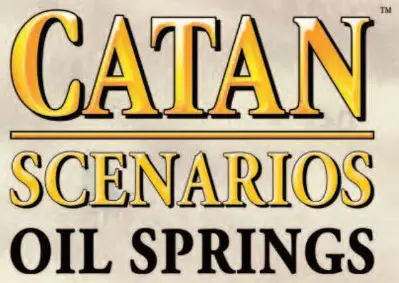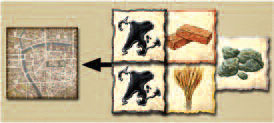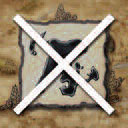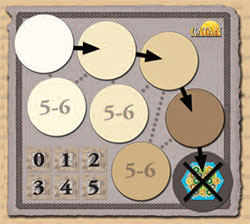
Eureka! Oil has been discovered on the island of Catan. The great engineers of Catan have learned ways to improve production using this valuable new resource, both by converting it into other resources and enabling the upgrade of cities into metropolises.
But oil is scarce and its use does not come without cost. Using oil produces pollution, as well as climate changing emissions, which bring with them the threat of coastal flooding-and absolute disaster. With the discovery of oil on Catan, its inhabitants face a new challenge: deciding whether the common good is worth limiting oil usage or whether the pursuit of victory is worth the risk of ruin.
Components
You will need all the components included in The Settlers of Catan (SOC) game.
Catan: Oil Springs, contains the following components, but not all of the them are used in a 3-4-player game:
- 21 oil tokens (use 15 for 3-4 players)
- (21 sequestered oil tokens on backs of oil tokens)
- 6 Metropolis tokens (use 4 for 3-4 players)
- 4 Oil Spring tiles (use 3 for 3-4 players)
- 1 Champion of the Environment token
- 7 Victory Point tokens
- 1 Disaster Track (with Disaster Track marker)
Setup
Lay out the board as shown below. Place Oil Spring tiles on the desert hex, the 9 forest hex, and northeast 10 pasture hex. The Robber starts off-board.
Place Disaster Track marker on the "0" on the Disaster Track.
Game Rules
Except where noted here, use The Settlers of Catan Rules.
Resource Production

Buildings on oil springs produce oil: one oil for a settlement, two for a city, and three for a metropolis.
Unlike resource cards, oil is distributed one at a time starting with the player who rolled, and then proceeds clockwise around the table, until all players receive what they've produced, or the supply is exhausted.
The robber may be placed on an oil spring. Oil is kept in front of players (always visible to all players). When a player is stolen from, the person robbing can choose to take one oil specifically instead of a resource card at random. If a 7 is rolled, count each oil as 1 card. If you have to discard due to a 7, you may choose to discard oil, putting it back into the supply.
Using Oil
There are 2 ways to use oil:
During your turn, you can convert 1 oil into 2 of the same, non-oil resource of your choice. You cannot use maritime trade to obtain oil (i.e., a 4:1 trade or a harbor cannot give you oil). However, Year of Plenty and Monopoly development cards can be used for oil.
You can use 1 brick, 1 grain, 1 ore and 2 oil to upgrade one of your cities to a metropolis by placing a Metropolis token underneath. A metropolis produces 3 resources instead of 2, is worth 3 victory points, and is immune to coastal flooding.

Multiple oil can be used per turn for both of these two options. Oil used to build is returned to the general supply. However, the usage of oil results in pollution. After every 5 oil are used, a disaster is triggered.
Keep track of this progression with Disaster Track marker on the Disaster Track-the token moves from 0 to 5.
Sequestering Oil

Alternatively, during your turn, you may choose to forgo the usage of 1 oil, sacrificing some growth for increased environmental security and the prestige of being a sustainability leader. In this case, on your turn flip one of your oil upside down in front of you (1 maximum per turn).
This "sequesters" the oil, permanently removing it from the game. For every 3 oil you sequester, you gain 1 Victory Point.
The first player to have sequestered 3 oil gains the "Champion of the Environment" token (worth 1 victory point). If another player sequesters more oil than the current Champion, he immediately takes the "Champion of the Environment" token.
Environmental Effects from Oil Usage For every five oil used (but not those that are sequestered or returned to the bank because of the robber), an environmental disaster results. This "disaster phase" is resolved after the turn has been completed but before the dice are passed to the next player.
Important Note: You can only use oil during a turn until a disaster is triggered. If the Disaster Track marker on the Disaster Track is on the 4, only one oil can be used during that turn (sequestering oil is not "usage" and thus does not count toward this progression).
If the marker is on a 1, then four oil could be used during that turn. At the end of that turn if a disaster has been triggered, resolve the disaster, and then reset the marker to zero.
The Disaster Phase
Each time the token on the disaster track reaches "5" (i.e., after the 5th, 10th, 15th, etc. oil is used), roll the two six-sided dice to determine where disaster strikes.
A "7" is Rolled
If a seven is rolled, a natural disaster triggered by climate change floods the coasts. Settlements bordering a sea hex are removed from the board (and returned to the affected player's supply), and cities are reduced to settlements.
Roads are not affected. A metropolis (because of its seawalls and other advanced design) is also not affected.
Note: Destroyed settlements can later be rebuilt, either at their previous locations or elsewhere. Please note that other players can now also build a settlement there (if possible).
A "7" is Not Rolled
If any number other than 7 is rolled, industrial pollution has struck and a hex with that number will be affected (see text box on the right). If there is only 1 hex with the number rolled, that hex is affected.
If more than 1 hex shares the same number, randomly select one to be affected. If the number rolled is no longer on any hex (because of previous disasters), nothing happens.
If the affected hex does not contain an oil spring, remove the production number token from the hex-that hex no longer produces resources. Place the removed number token on one of the open circles on the Disaster Track. If all spaces on the track are filled, the game ends.
If the affected hex contains an Oil Spring tile, remove 3 oil of the general supply from the game. These oil become part of the unrecoverable reserve-and thus are no longer accessible to the players.

Unlike hexes, Oil Spring tiles can continue to be hit by pollution throughout the game.
Note: If the general supply no longer contains oil and the only remaining oil is in players' hands, they discard one oil at a time, beginning with the player who caused the disaster and continuing clockwise around the board.
End of the Game
There are two ways to end this scenario:
-
The first player to reach 12 or more victory points after the end of his/her turn-which includes resolving the Disaster Phase if applicable-wins the game.
-
If the fifth number token is removed from one of the hexes, flooding has overwhelmed Catan and all inhabitants are forced to abandon the island, thus ending the game.
While no player truly wins, the player who currently holds the Champion of the Environment token achieves a "Pyrrhic Victory". That player is recognized by the international community for his/her efforts to mitigate climate change and is granted the most attractive land on a neighboring island to resettle.
Continue Reading


